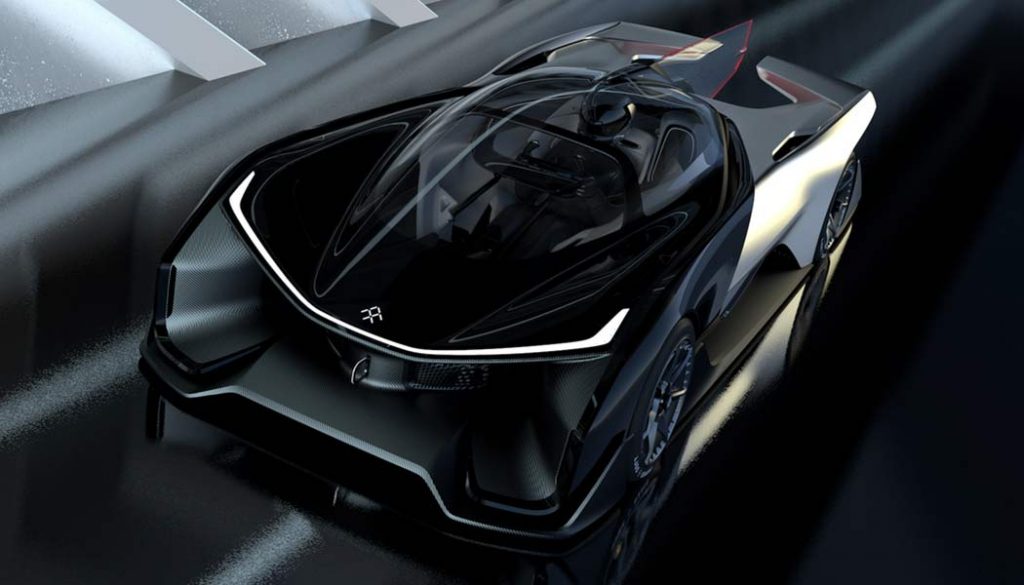

Last April Faraday Future broke ground in North Las Vegas on their 3,000,000 square foot 900 acre manufacturing site. A ground breaking ceremony is where the Governor of Nevada and a few Faraday Future executives don hardhats, pick up a shovel, smile for the camera and then get back in their cars and leave. Excavation is slated to start at the end of June with the first Faraday Future vehicle scheduled to roll out two years later.
Anyway you cut it, this is a big deal. It’s an even bigger deal when nobody really knows what Faraday Future is going to build. The startup electric auto manufacturer is going to change the industry and the way we think about mobility and transportation.
We know what won’t be built. The FFZERO1 electric supercar that is rated at 1,000 horsepower will not be built in the foreseeable future. The futuristic Batmobile looking, single seat ride is sweet to look at but it was a last ditch project to get something to display during their company launch at the CES show in Vegas last January.
Originally Faraday Future had planned to display a fully functional electric crossover but the technology just wasn’t ready. Plan B was to showcase a sports car with a more traditional electrical platform but that didn’t work either. They settled on building an inert supercar that looks like it belongs on a sci-fi set and pushed it up on the display stage.
In press releases they claim to have 13 models in the works. That’s a lot of different models but Faraday Future explains that their expandable, contractible platform and string battery technology make the large selection not only practical but profitable.
According to FF using innovative design and production techniques will allow them to bring vehicles to the market faster than traditional methods.
Think about it for a minute. If you are the governor of Nevada and a brand new car company approaches you and wants to turn 900 acres of scrub and desert into a state of the art manufacturing facility; they promised to create 4,500 new high paying jobs, had a stellar management team of former BMW and Tesla execs, and they had $1 billion to launch their business…would you give them a few tax breaks?
Nevada governor Brian Sandoval ponied up $500 million in tax breaks and development bonds to get the Faraday Future plant in his state.
What could go wrong?
Actually several things:
Related Search Topics (Ads)
Then there is the little problem with the competition. While Faraday Future never called itself the Tesla Killer they enjoy the press that some reporter’s label has generated for them. Faraday believes that Tesla’s market is too small to share and is focusing on bringing an entirely new kind of EV to the marketplace.
Tesla believes that the market might be a tad larger than Faraday Future thinks. Twenty-five miles from the proposed FF plant Tesla is building the Giga-Plant. It will be the building with the largest footprint of any structure in the world and will produce more lithium ion batteries in a year than produced worldwide in 2013.
Faraday Future will build conventional electric vehicles using their adaptable platform architecture to reduce manufacturing costs, but the ultimate EV, the one that will “change the way we think about mobility and transportation” will be autonomous.
Not only autonomous, but on demand. How often do you really need a vehicle in a given day, 3 to 4 hours? FF’s ultimate goal is to get you to rethink the need for car ownership. Their pet project has always been an autonomous ride-share taxi and that focus may not be so over the top. The ride-share market is heating up with Uber exploring autonomous vehicles and Toyota, VW and GMC investing heavily in both Uber and its competition.
During the early hype of January, Faraday claimed its vehicles would change the industry on the level that the iPhone changed cellular communications. The iPhone is the platform that allow incredible marketing access for businesses via apps, streaming, advertising etc. Perhaps that’s the real business model for FF. Remember, Jia Yueting’s company Leshi is heavy into media, entertainment and advertising. Maybe the autonomous car becomes the platform that converts the driver’s time from driving to consuming media.
At 2 to 3 hours per day per vehicle times say 500,000 vehicles, the platform creates a million plus hours a day of internet consumption time that can be monetized by the car maker’s affiliated businesses. It’s a pretty slick idea. Every sale of a Faraday autonomous vehicle creates residual income for Faraday’s partner companies.
We’re pretty sure that Governor Stanford of Nevada doesn’t really care what Faraday rolls out so long as it takes 4,500 people to do it. This could be a big political feather in his cap or, if Faraday rolls craps, the end of his career.
But hey, this is Vegas baby, winners go all in.
Related Search Topics (Ads)